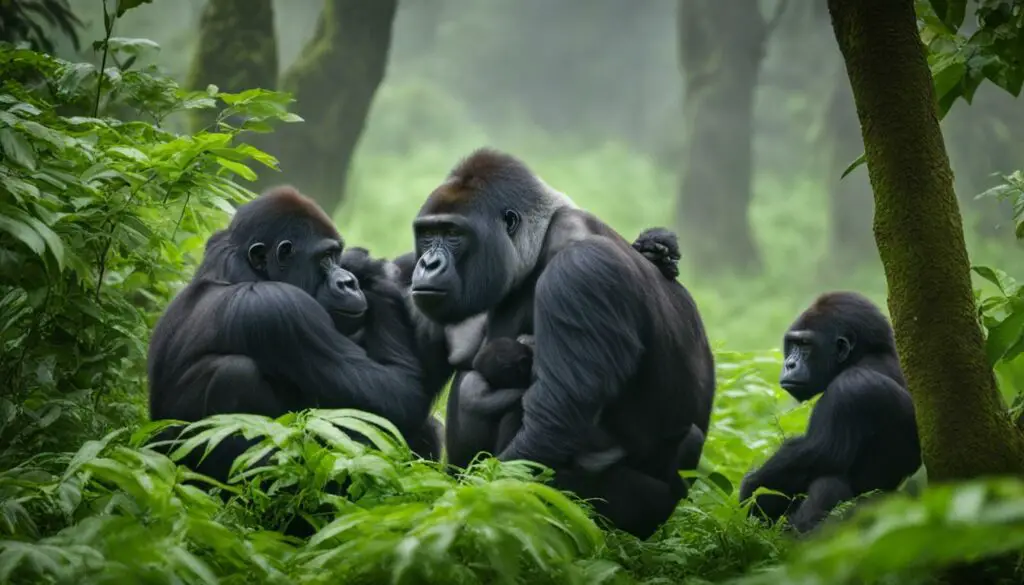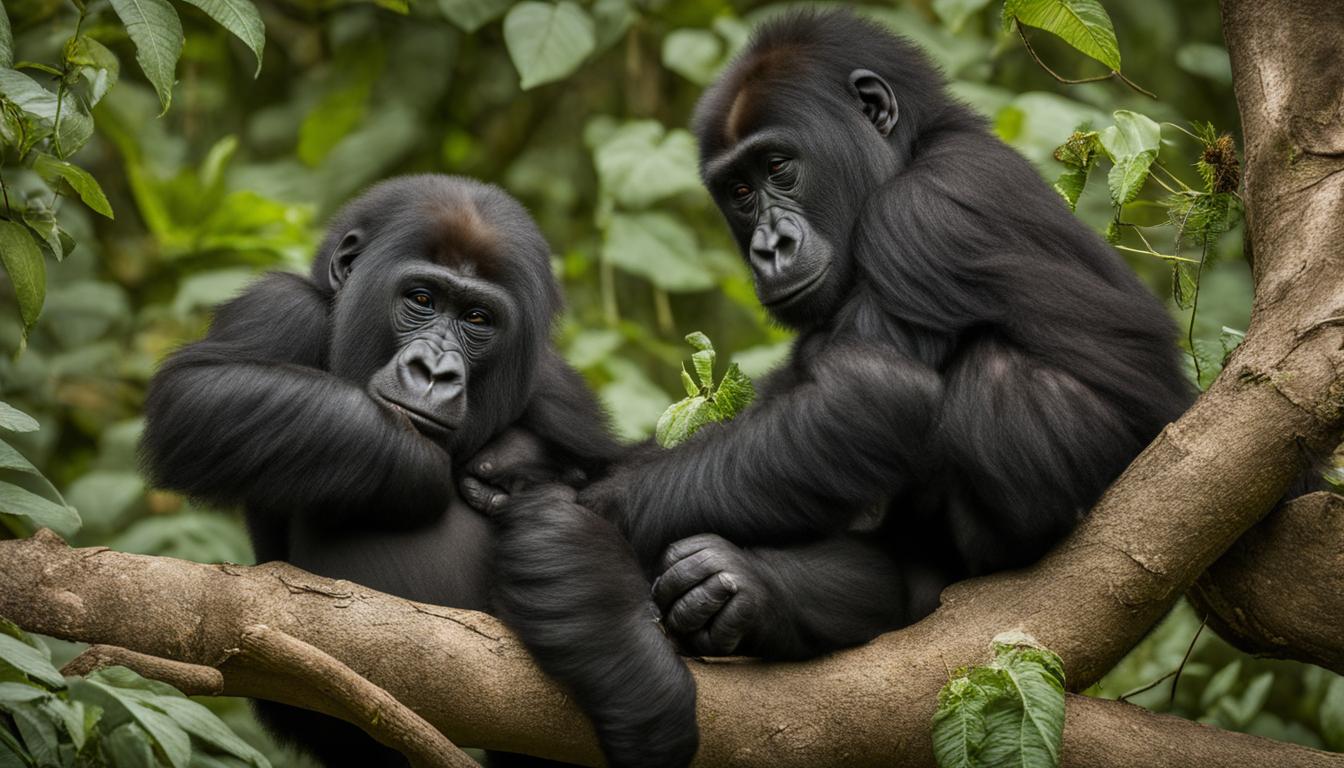Gorilla sibling bonds, also known as sibling relationships in gorillas, play a vital role in their social dynamics. Similar to humans, gorillas form lifelong bonds with their distant relatives. These gentle creatures exhibit complex social structures that involve both cooperation and competition.
Unlike most mammals, where sibling relationships occur during a specific phase of development or only with same-sex individuals, mountain gorillas are an exception. They reside with both maternally and paternally related siblings, of the same and opposite sex, throughout their lives.
Research has shown that gorillas have strong affiliative preferences for full and maternal siblings over paternal siblings or unrelated animals. However, aggression rates are indistinguishable among all types of dyads except mixed-sex dyads, where non-siblings engage in more aggression than siblings of any type.
Understanding the social bonding between gorilla siblings provides insight into the fascinating lives of these remarkable creatures and their unique familial structures.
The Role of Kin Recognition in Gorilla Sibling Bonds
Gorillas, like many other primates, exhibit kin recognition mechanisms that play a significant role in their sibling bonds. While some studies suggest that gorillas may be able to discriminate paternal kin, they still show a strong preference for maternal kin. This preference for maternal kin is unique to gorillas and contradicts the patterns observed in other non-human primates.
Age differences within sibling and non-sibling dyads can also influence social dynamics among gorillas. Siblings who are close in age are more likely to compete for parental resources. Additionally, the sex composition of the dyad can impact interaction styles. Males often engage in rough-and-tumble play as a way to practice for intrasexual competition in adulthood.
Gorilla sibling bonds are crucial for social cohesion within gorilla groups. Through kin recognition mechanisms and the understanding of sibling behavior, these gentle creatures develop strong affiliative bonds that shape their social dynamics and interactions.
Understanding the role of kin recognition in gorilla sibling bonds allows researchers and conservationists to gain insights into the complex social lives of gorillas. By studying their communication, behaviors, and relationships, we can develop a better understanding of how to protect and preserve these magnificent creatures in their natural habitats.
The Importance of Kin Recognition
Kin recognition plays a vital role in gorilla sibling bonds as it influences their behavior towards one another. This mechanism not only helps gorillas identify their siblings but also strengthens their affiliative preferences, promoting social cohesion within gorilla groups. By recognizing their kin, gorillas can form lasting bonds that contribute to the overall stability and well-being of the group.
Through kin recognition, gorillas can distinguish between maternal and paternal kin, with a greater emphasis on maternal relationships. This unique preference highlights the significance of maternal bonds and the importance of understanding sibling behavior in gorillas. By recognizing and valuing their maternal kin, gorillas establish strong foundations for cooperation, support, and protection within the group.
| Gorilla Sibling Interactions | Gorilla Sibling Communication |
|---|---|
| Close affiliative bonds | Non-verbal cues |
| Cooperative behaviors | Facial expressions |
| Social learning | Body postures |
| Rough-and-tumble play | Gestures |
Gorilla sibling bonds are characterized by close affiliative bonds, cooperative behaviors, and social learning. Non-verbal cues, such as facial expressions, body postures, and gestures, play a significant role in gorilla sibling communication. These communication methods allow gorillas to convey their intentions, emotions, and social hierarchies within the group.
The understanding of gorilla sibling behavior and the role of kin recognition provides valuable insights into the intricate social dynamics of these magnificent creatures. By recognizing and respecting the importance of sibling bonds, we can further support conservation efforts and ensure the well-being of gorillas in their natural habitats.
Gorilla Family Dynamics and Social Structure
Gorilla families have intricate social structures that play a vital role in their daily lives. Led by a dominant male silverback, these families typically consist of three to thirty individuals. The silverback serves as the protector and decision-maker for the group, while adult females, subordinate silverbacks, younger males (known as blackbacks), juveniles, and infants make up the remaining members.
Gorillas communicate with each other through various means, including facial expressions, sounds, postures, and gestures. In fact, studies have identified at least 22 distinct sounds that gorillas use to convey different emotions and messages to their family members. These modes of communication help maintain the cohesion and unity within the gorilla family unit.
Gorilla Sibling Bonds
Within a gorilla family, sibling bonds hold significant importance. Gorilla siblings learn from each other and engage in play, which helps them develop important social skills. The mother-child relationship is particularly strong, as is the bond between siblings. Gorillas form affiliative relationships by imitating each other’s behaviors and providing support in times of need. This strengthens their social connections and fosters a sense of unity within the family.
Extended Family Interactions
The dynamics within gorilla families extend beyond immediate family members. Similar to human societies, gorillas also engage in interactions with extended family members. These interactions involve cooperative behaviors, such as joint efforts in searching for food. By collaborating and working together, gorillas optimize their chances of survival and ensure the well-being of their family unit.
| Gorilla Family Structure | Key Features |
|---|---|
| Dominant Male Silverback | Leader and protector of the family |
| Adult Females | Support the silverback, often solicit mating from him |
| Subordinate Silverbacks | Assist the silverback in protecting the group |
| Younger Males (Blackbacks) | Transitioning from juveniles to adult silverbacks |
| Juveniles | Learning social skills and behaviors from older members |
| Infants | Receiving care and protection from the mother and other family members |
Gorilla Social Behavior and Group Dynamics
Gorillas exhibit fascinating social behavior and complex group dynamics that play a crucial role in their survival and development. Within gorilla groups, a clear dominance hierarchy is established, with the silverback as the leader. The silverback’s main responsibility is to protect the group from outside threats and mediate conflicts within the group. The females align themselves with the silverback and often seek his protection and support.
Cooperative behavior is also prevalent within gorilla groups. They work together to search for food, with older individuals often guiding the younger ones. This cooperative behavior not only ensures the group’s survival but also allows younger gorillas to learn important social skills and behaviors from their siblings and other group members. Young gorillas play a vital role in maintaining the social dynamics of the group and preparing for adulthood.
The social structure of gorilla groups is not static and can change over time. Aging silverbacks may face challenges from younger males within their own group, leading to shifts in power and the emergence of new leaders. These changes can have significant impacts on the group dynamics and may even involve infanticide as the new leader seeks to sire his own offspring. Females also have some power in shaping the group dynamics, as they can mate with multiple males to confuse paternity and earn protection.
Gorilla Dominance Hierarchy
The dominance hierarchy within gorilla groups is a key aspect of their social structure. It determines the distribution of resources, mating opportunities, and access to protection. The silverback, as the dominant male, holds the highest position in the hierarchy. However, the support of the females is crucial for maintaining his position. Females may align themselves with a new silverback leader if they don’t approve of the current one, indicating the influence they have in shaping the group dynamics.
Gorilla dominance hierarchies are not solely based on physical strength. Other factors, such as social intelligence and negotiation skills, also play a role. Lower-ranking individuals within the hierarchy may engage in submissive behaviors and avoid confrontation to maintain peaceful coexistence within the group. Understanding these complex dynamics is essential for gaining insights into the social lives of these majestic creatures and the factors that shape their behavior.
Table: Comparative Analysis of Gorilla Dominance Hierarchies
| Gorillas | Other Primates | |
|---|---|---|
| Number of Dominant Males | One (silverback) | Varies (multiple males) |
| Female Support | Crucial for maintaining dominance | Varies |
| Hierarchy Determinants | Physical strength, social intelligence | Physical strength, alliances |
| Changes in Hierarchy | Shifts over time, influenced by age and competition | Varies |
“Gorilla dominance hierarchies are complex and influenced by various factors such as physical strength, social intelligence, and female support.” – Jane Goodall
Challenges and Changes in Gorilla Group Dynamics
Gorilla group dynamics are complex and can undergo significant changes over time. One of the main challenges in gorilla social dynamics is the shift in power between aging silverbacks and younger males within the group. As a silverback ages, he may face competition from younger males who challenge his dominance. This power struggle can lead to a gradual shift in the balance of power within the group, potentially resulting in a new leader.
During these power shifts, younger silverbacks may engage in infanticide to eliminate the offspring of the previous leader and increase their chances of siring their own offspring with the females in the group. This behavior is a stark contrast to the close affiliative bonds that gorillas typically form within their family units. However, it serves as a powerful illustration of the complexity and fluidity of gorilla social behavior.
Gorillas are known for their close family bonds, but changes in group dynamics can lead to unexpected outcomes. When a silverback dies, females may choose to abandon the new silverback leader if they don’t approve of him. They may seek out another male within the group or even join a new group altogether. This ability of females to influence and shape the group dynamics highlights the importance of their role within gorilla societies.
Another challenge in gorilla group dynamics is the involvement of females in confusing paternity. They may engage in extra-pair copulations with males other than the dominant silverback, leading to uncertainty about the true paternity of offspring. This strategy may provide females with additional protection and resources from multiple males in the group. It also adds another layer of complexity to the social structure and dynamics within gorilla groups.
Gorilla Family Dynamics
Gorilla families are typically made up of a dominant silverback, adult females, subordinate silverbacks, younger males, juveniles, and infants. The silverback plays a crucial role as the leader, protecting the group from outsiders and mediating conflicts within the group. The close family bonds, particularly the mother-child relationship, are essential for the survival and well-being of the group. Gorilla siblings learn from each other, forming strong affiliative bonds that contribute to the overall cohesion of the family unit.
Gorilla group dynamics provide valuable insights into the social lives of these gentle creatures. Understanding the challenges and changes that occur in their social structure helps us appreciate the complexity of their interactions and the importance of sibling bonds within gorilla societies.
| Gorilla Group Dynamics Challenges | Gorilla Group Dynamics Changes |
|---|---|
| Shift in power between aging silverbacks and younger males | Power struggles leading to the emergence of a new leader |
| Infanticide by younger silverbacks to increase their chances of siring offspring | Females abandoning a new silverback leader if they don’t approve of him |
| Females engaging in extra-pair copulations to confuse paternity | Joining new groups or seeking other males for protection and resources |

In conclusion, gorilla group dynamics are influenced by various challenges and undergo changes over time. The shift in power between aging silverbacks and younger males, infanticide, and females’ role in confusing paternity all contribute to the complexity of gorilla social behavior. Understanding these dynamics helps us gain insight into the fascinating lives of gorillas and the significance of sibling bonds within their societies.
Conclusion
Gorilla sibling bonds are a fundamental aspect of gorilla social dynamics. These gentle creatures form strong affiliative preferences for their full and maternal siblings, establishing lifelong relationships. While aggression rates remain similar among all types of dyads, mixed-sex dyads stand out with higher aggression levels between non-siblings. The complexity of gorilla families is evident in their social structures, with a dominant male silverback leading the group and coordinating group interactions.
Kin recognition mechanisms and age differences within sibling dyads also play a crucial role in gorilla social dynamics. Gorillas demonstrate a preference for maternal kin, which contradicts patterns observed in other non-human primates. Additionally, siblings close in age are more likely to compete for parental resources, while the sex composition of the dyad affects interaction styles. Males often engage in rough-and-tumble play, preparing themselves for future intrasexual competition in adulthood.
Gorilla groups exhibit cooperative behavior and hierarchical relationships. The silverback, as the leader, protects the group and mediates conflicts. Female gorillas align themselves with the silverback and play a crucial role in supporting his position of power. Young gorillas learn social skills and behaviors from their siblings and other group members, contributing to the overall group dynamics.
The fluidity of gorilla social behavior is witnessed through changes in group dynamics over time. Aging silverbacks may face challenges from younger silverbacks within their own group, resulting in shifts in power. These changes can lead to the emergence of a new leader who may kill the infants in the group to sire his own offspring. Females also have influence, as they can mate with other males to confuse paternity and earn protection. In the event of the silverback’s death, females may abandon a new leader they disapprove of and seek another male to care for them.
Do Gorilla Siblings’ Interactions Affect their Social Hierarchy in the Group?
Gorilla siblings’ interactions play a crucial role in shaping the social hierarchies in gorillas. Through play, grooming, and conflict resolution, siblings establish their rank within the group. These interactions are essential for the development of their social skills and ultimately influence their standing within the gorilla community.
FAQ
How do gorilla siblings interact and form bonds in the group?
Gorilla siblings form lifelong bonds with both maternally and paternally related siblings, residing with them throughout their lives. They learn from and imitate each other, developing close affiliative bonds.
What role does kin recognition play in gorilla sibling bonds?
Gorillas exhibit kin recognition mechanisms that influence their behavior towards siblings. While some studies suggest they may discriminate paternal kin, they show a strong preference for maternal kin. This preference is unique to gorillas and contradicts patterns observed in other non-human primates.
How do gorilla family dynamics and social structures work?
Gorilla families are led by a dominant male silverback, who serves as the group’s protector and decision-maker. The other members include adult females, subordinate silverbacks, younger males, juveniles, and infants. Gorilla families exhibit complex social structures, with extended family-like interactions beyond immediate family members.
What is the social behavior and hierarchy within gorilla groups?
Gorilla groups have a clear dominance hierarchy, with the silverback as the leader. The females align themselves with the silverback and often solicit mating from him. Cooperative behaviors, such as joining forces to search for food, are also observed. Young gorillas learn social skills and behaviors from their siblings and other group members.
How do challenges and changes impact gorilla group dynamics?
Aging silverbacks may face challenges from younger males within their own group, leading to shifts in power. Changes in group dynamics can occur gradually, with a new leader potentially killing infants to sire his own offspring. Females also play a role in determining group dynamics, as they can mate with other males to confuse paternity and earn protection.
What can gorilla sibling bonds teach us about their social lives?
Gorilla sibling bonds play a crucial role in gorilla social dynamics. They provide insight into complex social behavior, hierarchical relationships within groups, and the importance of affiliative relationships beyond immediate family members. Gorillas exhibit both cooperation and competition, similar to humans, making their social lives fascinating to study.










